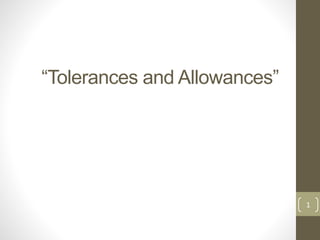
Tolerances and allowances
- 2. For more help contact me Muhammad Umair Bukhari Engr.umair.bukhari@gmail.com http://onlinemetallurgy.com
- 3. Main points: Tolerances and allowances. Interchangeable manufacturing. Ideal interchangeable manufacturing. Factors affecting ideal interchangeable manufacturing. Basic requirements-Basic dimensions. Why tolerances are specified…??? Unilateral and Bilateral Tolerances. 3
- 4. Tolerance Tolerance is the total amount that a specific dimension is permitted to vary; It is the difference between the maximum and the minimum limits for the dimension. For Example a dimension given as 1.625 ± .002 means that the manufactured part may be 1.627” or 1.623”, or anywhere between these limit dimensions. It is the difference between the permitted minimum and maximum sizes of a part. 4
- 5. Tolerances and Allowances Modern industry has developed on the basis of interchangeable manufacturing. The interchangeable manufacturing means the production of parts to such a degree of accuracy as is necessary to permit the assembly and proper functioning of the parts without further machining or fitting, although the individual parts may have been made at different times or in different manufacturing plants. In other words, the parts are theoretically, at least, interchangeable. 5
- 6. 6
- 7. Allowance 7
- 8. 8
- 9. Basic Requirements-Basic Dimensions A basic dimension is the theoretical size, which, for practical reasons, is only approximated; or, it is the dimension that would be obtained if perfection were possible and did not result in increased costs. However, since perfection is impossible and also unnecessary, so far as the dimensions of machine parts are concerned, it is general practice to give a base or basic dimension and then indicate by supplementary “tolerance” dimensions just how much the actual dimension can vary from the basic without causing trouble, how much inaccuracy is allowable allow able without causing a part to fit or function improperly. 9
- 10. Basic Requirements-Basic Dimensions (contd…) During inspection a surface scratch on a component cabinet is assessed or judged to be unacceptable to customer. The inspection criterion calls for “no scratches” and the inspection call is a pass/fail or go/no go option. However such scratches can also be held to a range or “tolerance” of acceptance. 10
- 11. Why tolerances are specified…??? The tolerances are applied to the dimension of all manufactured parts. A tolerance indicates how much a part may deviate from its ideal or basic dimension and still function properly. For example a bearing may require a 1-inch diameter bore to accommodate a 1-inch diameter journal. To make the bearing exactly 1- inch would be impossible , and even if this could be done, the bearing would wear in actual use to a somewhat larger dimension. 11
- 12. Unilateral and Bilateral Tolerances Unilateral Tolerance The term unilateral tolerance means that the total tolerance, as related to a basic dimensions, is in one direction only. For example, if the basic dimension were 1-inch and a tolerance of 0.002-inch were expressed as 1.00 - 0.002, or as 1.00 + 0.002, these would be unilateral tolerances, since the total tolerance in each case is in one direction. 12
- 13. bilateral tolerance If the tolerance were divided so as to be partly plus and partly minus, it would be classed as bilateral tolerance. Thus, 1.00(+0.001 & -0.001) is an example of bilateral tolerance, because total tolerance of 0.002 is given in two directions– plus and minus. 13
- 14. 14
- 15. THANK YOU…!!! 15
